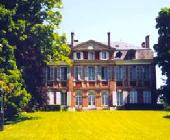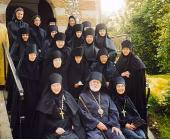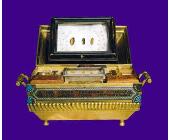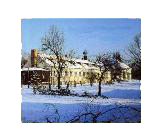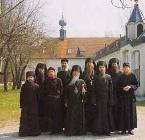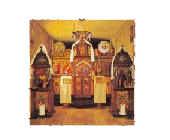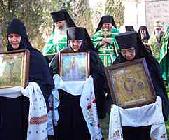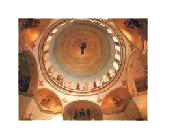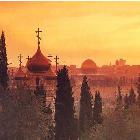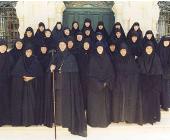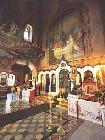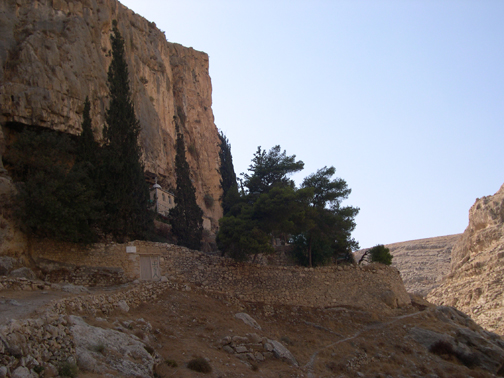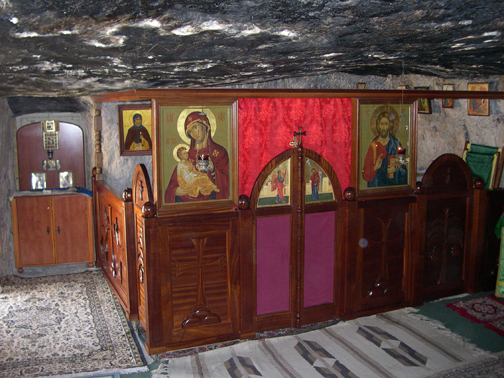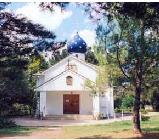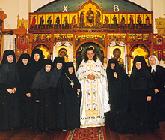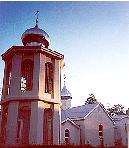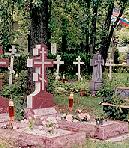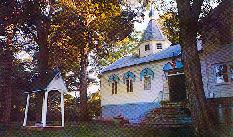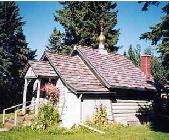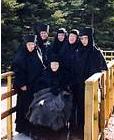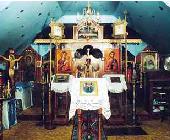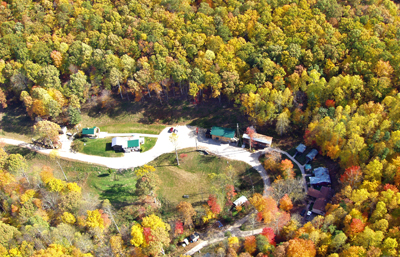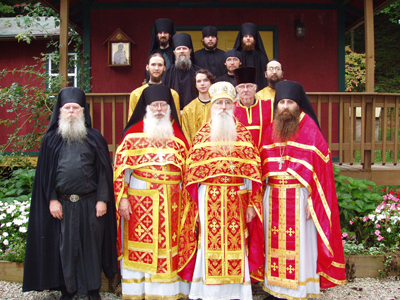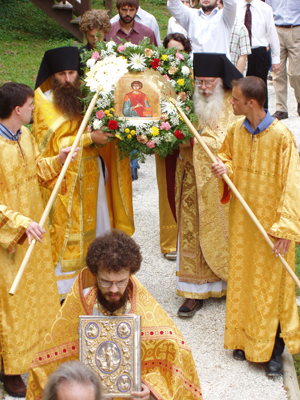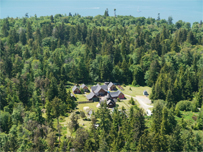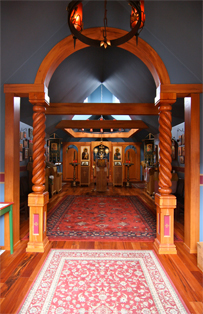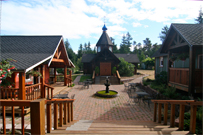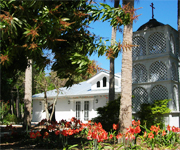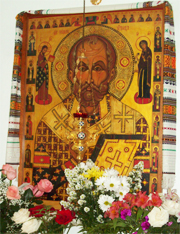I took this from the "Pious Fabrications Blog," w/o permission. I think it's great, and I truly did this because I admire the mans writing!
-vadermask 3/28/12
† † †
The African Roots of Christian Spirituality
Today, Christianity is generally thought of as a largely European and, due to European immigration and influence, North American religious and cultural movement. Christianity's recent and ongoing remarkable growth in the so-called “Global South” of Latin America, Africa, and southern and eastern Asia, however, coupled with a significant decline in adherents to Christianity in Europe, poses a significant challenge to that assumed European hegemony of Christendom.
1 There are many new questions that have arisen as a result of these recent changes, including what the decline of Christianity in Europe means for the future of the Western Civilization which it shaped and what new forms Christianity will take as it becomes fused to new cultures. The most central question being asked by Christians from both Europe and Africa is whether these forms will be faithful to the Christianity the world has known for the past 2000 years or will become something else entirely.
2

Too often overlooked in these discussions are the monumental contributions that non-Europeans have already made to the Christian faith, even in its supposedly European forms. This is especially true of Africa, whose residents played a central role in Christianity's first several hundred years. Great early and early Medieval Christian figures like the apologist Tertullian, the first Christian to write extensively in Latin, Athanasius and Cyril of Alexandria, whose Christology became the dominant understanding of the nature and role of Jesus to the vast majority of Christians throughout the world, and Augustine of Hippo, arguably the single most influential Christian thinker after the apostle Paul, were all Africans.
3 The greatest contribution that Africa made to Christianity, though, was in the practice, piety, and intense devotion of the pioneers of Christian monasticism. Men and women like Anthony the Great, Pachomius the Great, and Syncletica of Alexandria, remembered by subsequent generations of Christians as the Desert Fathers and Mothers, developed a unique ascetic and mystical approach to Christianity which has been a major influence on all subsequent Christian history and continues to shape Christian practice, belief, and culture today.
The roots of Christian monasticism, a dedication to the practices of ascetic struggle and constant prayer coupled with a rejection of normal social expectations like marriage and family life, reach back to the faith's earliest days and even beyond. Judaism, from which Christianity emerged as a new religion, already possessed monastic traditions “like the Essenes or the group at Qumran from which the Dead Sea Scrolls come, or the Therapeutae of Egypt described by Philo of Alexandria.”
4 It is not to be overlooked that the latter monastic group was specifically located in Egypt, near Alexandria, the same geographic location in which Christian monasticism would first spring up in its fullest form.
In writings that would later become part of the New Testament, the apostle Paul, writing in the middle of the first century, counseled widows, virgins, and unmarried men to remain unmarried and to use the freedom this afforded them to serve and worship God.
5 Bart D. Ehrman, a scholar and professor of early Christian writings, suggests “it may have started with Jesus himself, who anticipated that this world and life as we know it would all come to an abrupt end when God appeared in judgment to overcome the forces of evil in control of this earth and set up his own Kingdom.”
6 “If this world is soon to disappear, why be attached to its pleasures?” Ehrman goes on to ask, inviting us into the thought of the early Christians, and concluding, as many of them did, “It is better to prepare for the coming Kingdom, living simply and humbly in expectation of that final day.”
7 This was certainly the thinking that led Anthony the Great, the earliest major figure of Christian monasticism, to take up the ascetic way of life.
According to the biography of Anthony written by Athanasius of Alexandria, an influential fourth century bishop of Alexandria, Egypt, Anthony entered into a church one day, “and it happened the Gospel was being read, and he heard the Lord saying to the rich man, 'If thou wouldest be perfect, go and sell that thou hast and give to the poor; and come follow Me and thou shalt have treasure in heaven.'”
8 Antony, so Athanasius relates, went out of the church immediately and gave away the entirety of the inheritance he had received from his parents, who had recently died, commended his young sister into the care of an order of Christian virgins in Alexandria, and sojourned to the wilderness to take up the life of a hermit and ascetic.

Though not the first to retreat into the deserts of Egypt, Anthony's example gained such reverence and notoriety that he inspired thousands more to imitate him. After the legalization of Christianity by the first Christian Roman emperor, Constantine I, in 313 and the elevation of Christianity from the status of a persecuted minority religion to that of one with official imperial favor throughout his reign, which lasted until his death in 337, and beyond, ever larger numbers of former pagans began to flock to the churches for conversion. Very often, perhaps more often than not, these conversions were halfhearted and for the purpose of attaining political, social, or economic gain, keeping up with the changing times and trying to remain with the “in-crowd,” rather than being inspired by any real adoption of or devotion to the tenants of Christianity.
9 According to Michael A. Smith, a scholar of early Christianity and Baptist minister, this dramatic “growth in numbers was accompanied by a lowering of standards.”
10 “The monks,” on the other hand, “aimed to live the Christian life to the full, and felt that continued residence in the 'world' hindered this. They tried to achieve a pure Christianity and a deep communion with God which they considered unattainable in the existing churches.”
11 According to scholar and philosopher David Bentley Hart, “enthusiasm for the monastic life became so great that, as a famous quip put it, the desert had become a city.”
12
One of the most incredible features of this new enthusiasm was the nature of the practices which so many flocked to the Egyptian deserts to engage in. According to Athanasius, Anthony
kept vigil to such an extent that he often continued the whole night without sleep; and this not once but often... He ate once a day, after sunset, sometimes once in two days, and often even in four. His food was bread and salt, his drink, water only... A rush mat served him to sleep upon, but for the most part he lay upon the bare ground.13
The monks who followed Anthony's example sought to imitate his extreme asceticism. According to Smith, “the main routine of the hermit was prayer and meditation, supplemented by reading of the Bible. Fasting was also important and they attempted many other rigorous feats such as standing for hours while praying.”
14 This “extreme deprivation taught self-mastery, and was itself a physical form of prayer.”
15
In addition to continuing the typical Christian prayer practices, such as the recitation of psalms and liturgical Eucharistic rituals, however infrequently the monks were able to gather for the latter, the monks also developed a new form of prayer, to which they attributed especially great spiritual efficacy. This new method of prayer was first fully described by John Cassian, a European Christian who traveled to Egypt to speak with the monks there, in the late fourth century. In his
Conferences, a record of interviews he conducted with some of the most renowned monks of Egypt, Cassian wrote that “every monk in his progress towards continual recollection of God, is accustomed to ponder” a short prayer, “ceaselessly, revolving it in his heart.”
16 Though a variety of short prayers were used by the monks, the most commonly used in Cassian's time in the late fourth and early fifth centuries, according to Cassian, was the opening verse of Psalm 70: “O God, make speed to save me; O Lord, make haste to help me.” The monks recited this and other short prayers like it continuously as they worked and ate, and even spoke, read, and slept. The purpose of the extreme ascetic practices, they said, was to train the body in order to make this continuous repetitious prayer possible, “for he cannot possibly keep his hold over it unless he has freed himself from all bodily cares and anxieties.”
17

The final goal which the monks set before them was one of union with God via continuous and automatic prayer and recollection of him. In the words of Elaine Pagels, a professor of religion at Princeton University, “Anthony – and others like him – sought the shape of his own soul, hoping to accept the terrors and ecstasies of direct and unremitting encounters with himself and, having mastered himself, to discover his relationship to the Infinite God.”
18 This was, ultimately, the purpose behind the asceticism and constant prayer of the monks. John Cassian related that the monks believed that through these practices
our mind will reach that incorruptible prayer … [which is characterized by being] ... not merely not engaged in gazing on any image, but is actually distinguished by the use of no words or utterances; but with the purpose of the mind all on fire, is produced through ecstasy of heart by some unaccountable keenness of spirit, and the mind being thus affected without the aid of the senses or any visible material pours it forth to God with groanings and sighs that cannot be uttered.19
One of the stories of the Desert Fathers, recorded in one of the several collections of the sayings and doings of the early Egyptian monks which made very popular reading throughout the Middle Ages, records an even more vivid description of the spiritual goal the monks set forth for themselves. According to the dramatic short story,
Abba20 Lot went to Abba Joseph and said, 'Abba, as far as I can, I keep a moderate rule, with a little fasting, and prayer, and meditation, and quiet: and as far as I can I try to cleanse my heart of evil thoughts. What else should I do?' Then the hermit stood up and spread out his hands to heaven, and his fingers shone like ten flames of fire, and he said, 'If you will, you can become all flame.'21
The effect that this vibrant new Christian spirituality, intensely ascetic and mystical, had upon the popular consciousness, faith, and practice of Christians of later generations cannot be overstated. The Egyptian monks provided inspiration to men like Benedict of Nursia, whose Rule, based in large part on the ways of the Desert Fathers as recorded in the collections of their sayings and in the writings of John Cassian, became the standard monastic discipline in Western Europe through the Middle Ages and beyond.
22

Their influence extended well beyond the cloister as well. Their technique of repetitious prayer gave birth to the Rosary and the Jesus Prayer,
23 popular extra-liturgical devotional practices in Roman Catholic and Eastern Orthodox Christianity respectively, both involving the repetition of short prayers whose number is tracked by counting on a set of beads, in the case of the former, or knots in a rope, in the case of the latter.
24 In addition to this outward introduction of new practices into the repertoire of Christian spirituality, the Desert Fathers also had a remarkable impact on Christianity's core, centering the goal of the Christian life in inner prayer, stillness, and mystical union with God.
25 This emphasis on the mystical side of Christianity had a great impact on such influential Christian mystics as Bernard of Clairvaux, Francis of Assisi, George Fox, Seraphim of Sarov, and Thomas Merton; in fact, the mystical tradition of which these and dozens of others were a part and the monastic tradition of which all but one of these was a part would not have existed at all had it not been for the influence of the Desert Fathers.
In addition to their impact on Christian spirituality, the Desert Fathers also had a significant impact on European popular culture throughout the Middle Ages and later times. According to Benedicta Ward, herself a Christian nun in the Anglican tradition, “they have inspired poetry, drama, opera and art as well as withdrawal into solitude and prayer.”
26 Whereas the first several centuries of Christians had found both inspiration and entertainment in the accounts of the deaths of the martyrs, such as the famous account of
The Passion of Perpetua and Felicitas, perhaps written by the African Christian apologist Tertullian in the early third century, after the legalization of Christianity and the end of the age of the martyrs, the sayings and hagiographies of the Desert Fathers and other monastic saints who followed in their footsteps became standard Christian literary fare.
27 Throughout the Middle Ages, the sayings and lives of the great monastic saints were popular Christian literature. “The first and most influential of such biographies” was, according to scholar Jaroslav Pelikan, “Athanasius's
Life of Saint Anthony,” the original fourth century account of the original Desert Father.
28

Perhaps one of the most famous examples of the place of the Desert Fathers in more recent European popular culture is the 1647 painting of
The Temptation of St. Anthony by the Flemish artist David Teniers the Younger.
29 Though Teniers' painting is one of the most famous, this same scene has also been depicted by such great artists as Fra Angelico, Hieronymous Bosch, Michelangelo, and Salvador Dalí.
The Temptation of St. Anthony also became the title and subject of a novel by the famous author Gustave Flaubert and, more recently, an opera, based upon Flaubert's book, by Bernice Johnson Reagon.
30
The Egyptian monks and their brand of Christian spirituality have also shown up in some rather surprising places in Western popular culture. One very recent example is the 1961 novel
Franny and Zooey by J.D. Salinger, the author most famous for writing
The Catcher in the Rye.
31 In the novel, Franny, one of the title characters, carries around a copy of the 19th century anonymously written Russian book
The Way of a Pilgrim, a story of a wanderer who travels throughout Russia reading and discussing the writings of the Desert Fathers and practicing their method of repetitive prayer;
32 Franny also reveals that she herself prays the Jesus Prayer in a search for mystical experiences and spiritual enlightenment.
The Desert Fathers also had a number of unintended and unexpected effects on the subsequent developments of Christian theology. The most significant of these indirect consequences of the early Egyptian monks' pioneering ways may be the conversion to Christianity of Augustine of Hippo, one of the most important and influential Christian thinkers in all of Christian history, and himself a fellow African. Augustine, whose theology would later become the standard understanding of the Christian faith for the majority of Christians, originally struggled with acceptance of Christianity, wavering in his decision to join the Church. He was deeply impressed, however, by the example of Anthony. He relates his own reaction to first hearing about Anthony in his
Confessions, writing as if speaking to God that “we were amazed, hearing Thy wonderful works most fully manifested in times so recent, and almost in our own, wrought in the truth faith and the Catholic Church.”
33 Later, in deep emotional turbulence over his indecision in his religious beliefs, he recalled the example of Anthony. According to Augustine,
I had heard of Anthony, that, accidentally coming in whilst the gospel was being read, he received the admonition as if what was read were addressed to him, “Go and sell that thou hast, and give to the poor, and thou shalt have treasure in heaven; and come and follow me.” And by such oracle was he forthwith converted unto Thee. So quickly I returned to the place where Alypius was sitting; for there had I put down the volume of the apostles, when I rose thence. I grasped, opened, and in silence read that paragraph on which my eyes first fell.34
The passage which Augustine opened up to and read, Romans 13:13-14,
35 struck him deeply and finally convinced him to convert to Christianity. The Desert Fathers, then, were indirectly responsible for inspiring one of the most important figures in Christian history to become a Christian in the first place.

The Desert Fathers also served the world indirectly by creating a system which would ultimately save European literature, heritage, and culture from destruction. After the collapse of the Western Roman Empire in the fifth century, the monasteries of Europe became repositories of learning, preserving art, literature, and the art of literacy through a period of rapid and dramatic European cultural decline and rampant warfare.
36 It was because of the monastics in Europe, part of that tradition founded by their forerunners in Africa, that Europe was able to save the Classical heritage of the Romans and Greeks from being destroyed.
The Desert Fathers were a ragtag group of men and women who came from a variety of backgrounds and had a diversity of characteristics and personalities, as can easily be seen from the titles attached to the names of many of them, such as John “the Dwarf,” Moses “the Strong” (also known as Moses “the Robber” and Moses “the Black”), and Paul “the Hermit.” Some, like Moses, had been outlaws before venturing into the monastic life in the desert, others, like Abba Arsenius, had been educated men of the Roman upper classes, others, like Pachomius, had been soldiers and civil servants, and still others, like Anthony the Great, had been peasants and farmers. As diverse a group as they were, what they all had in common was that they retreated into the deserts of southern Egypt in a search for a more intimate and personal relationship with their God and, in so doing, pioneered a new Christian way of life, one that would spread out through and from Africa and conquer the whole of the Christian world.
The Christian monastic, mystical, spiritual, and devotional traditions of today all trace their lineage back directly to these men and women in the deserts of Egypt in the fourth and fifth centuries. As Christianity continues to dwindle in numbers in Europe, with which continent it has come to be associated in the modern mind, and rises in prominence and numbers in other places in the world, especially Africa, it is in fact not going somewhere new but returning home.
Notes
5 For instance, 1 Corinthians 7.
7 Ibid., 45.
11 Ibid.
13 Athanasius, 197-8.
14 Smith, 205.
16 John Cassian, “The Conferences,” part 10, chapter 10, in Nicene and Post-Nicene Fathers, Second Series, Vol. 11: Sulpitius Severus, Vincent of Lerins, John Cassian, eds. Philip Schaff and Henry Wace (Peabody: Hendrickson Publishers, Inc., 1994), 405.
17 Ibid.
19 John Cassian, 408.
20 “Abba” is the word in many Semitic languages for “father.” It is still used by most Middle Eastern Christians as a form of address for their priests and monks and is the origin of the English word “abbot,” used for the head of male monasteries.
22 Ibid., xx.
23 “Lord Jesus Christ, Son of God, have mercy upon me, a sinner.”
24 Matthewes-Green, 5.
25 Bishop Kallistos Ware, The Orthodox Way (Crestwood: St. Vladimir's Seminary Press, 1995), 122.
26 Ward, xxii.
28 Ibid., 135.
29 Hart, 58.
33 Augustine, “The Confessions of St. Augustin,” Book 8, Paragraph 14, in Nicene and Post-Nicene Fathers, First Series, Vol. 1: The Confessions and Letters of Augustine, with a Sketch of his Life and Work, eds. Philip Schaff and Henry Wace (Peabody: Hendrickson Publishers, Inc., 1994), 122.
34 Augustine, Book 8, Paragraph 29, 127.
35 As quoted by Augustine in his Confessions, “Not in rioting and drunkenness, not in chambering and wantonness, not in strife and envying; but put ye on the Lord Jesus Christ, and make not provision for the flesh, to fulfill the lusts thereof.”
Bibliography
Ware, Bishop Kallistos. The Orthodox Way. Crestwood: St. Vladimir's Seminary Press, 1995.










